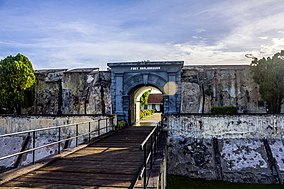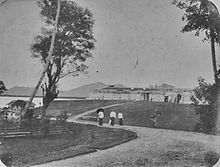
Sir Thomas Stamford Bingley Raffles was a British statesman who served as the Lieutenant-Governor of the Dutch East Indies between 1811 and 1816, and Lieutenant-Governor of Bencoolen between 1818 and 1824. He is best known mainly for his founding of modern Singapore and the Straits Settlements.
The Anglo-Dutch Treaty of 1824, also known as the Treaty of London, was a treaty signed between the United Kingdom and the Netherlands in London on 17 March 1824. The treaty was to resolve disputes arising from the execution of the Anglo-Dutch Treaty of 1814. For the Dutch, it was signed by Hendrik Fagel and Anton Reinhard Falck, and for the British, George Canning and Charles Williams-Wynn.

Bengkulu is a province of Indonesia. It is located on the southwest coast of Sumatra. It was formed on 18 November 1968 by separating out the former Bengkulu Residency area from the province of South Sumatra under Law No. 9 of 1967 and was finalized by Government Regulation No. 20 of 1968. Spread over 19,813 km2, it is bordered by the provinces of West Sumatra to the north, Jambi to the northeast, Lampung to the southeast, and South Sumatra to the east, and by the Indian Ocean to the northwest, south, southwest, and west.

Bencoolen Street is a street in Central, Singapore that starts at the junction of Rochor Road, Rochor Canal Road and Jalan Besar and ends at the junction of Fort Canning Road, Stamford Road and Orchard Road. The street houses several landmarks including Sim Lim Square, Bencoolen Mosque and Albert Complex. A number of hotels and serviced apartments exist, namely Summer View Hotel, Bayview Hotel Singapore, Hotel 81 Bencoolen, Strand Hotel, Rendezvous Hotel and Somerset Bencoolen. It is accessible via Bencoolen MRT station which is located under Bencoolen Street itself.

Bengkulu is the capital of the Indonesian province of Bengkulu. The city is the second largest city on the west coast of Sumatra Island after Padang. Previously this area is under the influence of the kingdom of Inderapura and the Sultanate of Banten. The city also became the exile of Sukarno during the period of 1939 - 1942. It covers an area of 151.70 km2 and had a population of 308,544 at the 2010 Census and 373,591 at the 2020 Census. The city is also the largest city of Bengkulu Province.
The dollar was the currency of British colony of Bencoolen on the west coast of the island of Sumatra until the Anglo-Dutch Treaty of 1824, when the British Empire traded away Bencoolen for Malacca.
Joseph Collett (1673–1725) was a British administrator in the service of the British East India Company. He served as the deputy-governor of Bencoolen from 1712 to 1717 and as governor of the Madras Presidency from 1717 to 1720. He re-built Hertford Castle in England and stood for election to the British Parliament.
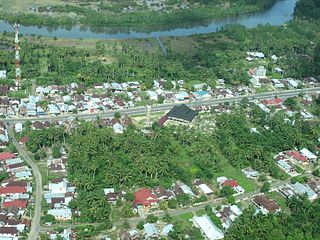
Mukomuko is a regency of Bengkulu Province, Indonesia, on the island of Sumatra. It covers a land area of 4,146.52 km2 and had a population of 155,753 at the 2010 census, which rose to 190,498 at the 2020 census. The administrative centre of the Mukomuko Regency is Mukomuko town.

Fort Rotterdam is a 17th-century fort in Makassar on the island of Sulawesi in Indonesia. It is a Dutch fort built on top of an existing fort of the Gowa Kingdom. The first fort on the site was constructed by the a local sultan in around 1634, to counter Dutch encroachments. The site was ceded to the Dutch under the Treaty of Bongaya, and they completely rebuilt it between 1673 and 1679. It had six bastions and was surrounded by a seven meter high rampart and a two meter deep moat.
Bengkulu, historically spelled as Bencoolen or Benkoelen , is a province of Indonesia on the island of Sumatra.
List of Governors, Deputy Governors, Residents, Lieutenant-Governor of the Presidency and Residency versions of British Bencoolen.

British Bencoolen was a possession of the British East India Company (EIC) extending about 300 miles along the southwestern coast of Sumatra and centered on the area of what is now Bengkulu City. The EIC established a presence there in 1685, and in 1714 the EIC built Fort Marlborough there. A local datoo allowed EIC to build the fort in order to protect the settlement from the Dutch.
Benkoelen Residency, also spelled Bencoolen, is an administrative subdivision of the Dutch East Indies, covering the present-day province of Bengkulu, Indonesia. It was one of the control center of the Dutch before independence, though after independence it became the resident of Bengkulu prefect. Initially it was the part of Sumatra, with the division of Sumatra, it became the part of Southern Sumatra. Further, on the demand of Bengkulu Struggle Agency and according to Law no. 9/1967 Junkto Government Regulation no. 20/1968, Bengkulu became an all-new province, thereby making the Benkoelen Residency a part of it.
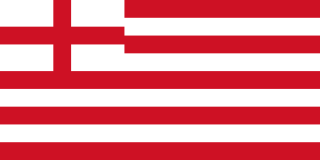
Bantam Presidency was a presidency established by the British East India Company and based at the Company factory at Bantam in Java. Founded in 1617, the Presidency exercised its authority over all the Company factories in India, including the agencies of Madras, Masulipatnam and Surat. The factors at Bantam were instrumental in founding the colony of Madraspatnam in 1639 with the Fort St. George, which later grew into the modern city of Madras. The Presidency of Bantam was twice downgraded, first in 1630 before being restored in 1634 and for the second time in 1653, when owing to the hostility of Dutch traders, the Presidency was shifted to Madras.
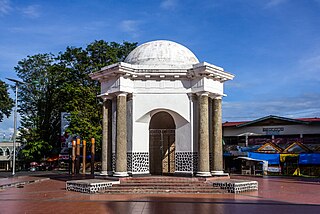
The Thomas Parr Monument is a monument located in Bengkulu, Bengkulu, Indonesia and dedicated to Thomas Parr, the British Resident of Bengkulu who was killed in 1807. Constructed the year after his death, it is considered a cultural property of Indonesia.
York was launched in 1773 as an East Indiaman' She then made five voyages for the British East India Company (EIC) between 1773 and 1787. She then became a general merchantman and was last listed in 1794.
Thomas Church, was a British colonial administrator under the British East India Company. Church started as a writer in Bencoolen (Bengkulu) in 1816 and rose to the high position of Resident Councillor of Singapore before retiring in 1856.

The invasion of the Spice Islands was a military invasion by British forces that took place between February to August 1810 on and around the Dutch owned Maluku Islands also known as the Spice Islands in the Dutch East Indies during the Napoleonic wars.
Osterley was an East Indiaman launched on 9 October 1771 by Wells, Deptford. She made two voyages for the British East India Company (EIC) before the French frigate Pourvoyeuse captured her on 21 February 1779 while she was on her third voyage. She then sailed for a few years as a French merchantman.
